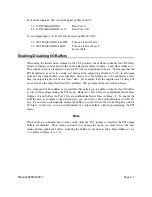
Page 2-5
Manual 00650-529-1
System should set the PNP CMOS option to BIOS or Motherboard. Save the option and
continue booting the system.
If you are using Windows95, your operating system should detect the new hardware and prompt
you for the installation disk. The simplest option is to insert the diskette provided into the A drive
and allow the operating system to look for the files that it wants.
Alternatively, if you have already installed the software to your computer, you can specify the
installation directory instead of allowing Windows95 to look around. Either option will work
acceptably. Please note that even though Windows95 looks for and finds software to install, no
driver is actually installed, used, or needed. This step merely tells Windows95 where to place the
card in the registry of devices. You can find the installed card in Device Manager, under the class
Data Acquisition. Use this method to determine the card's base address as PCIFind.EXE may or
may not work under your specific installation of Windows95.
If you are not using Windows95, or if your installation of Windows95 does not detect the new
hardware you installed, run PCIFind.EXE to determine the base address that the computer
assigned. PCIFind uses the Vendor ID and Device ID to search for your card, then reads the base
address and IRQ assigned. If you want to determine the base address and IRQ assignment
yourself, the Vendor ID code is 494F (ASCII for "I/O") and the Device ID codes are:
PCI-DIO48(S): 0C60
PCI-DIO48(S)S: 0E60
The base address assigned by BIOS or the operating system can change each time new hardware is
installed into or removed from the computer. Please re-check PCIFind or Device Manager if the
hardware configuration is changed,
Input/Output Connections
To ensure that there is minimum susceptibility to EMI and minimum radiation, it is important that
the card mounting bracket be properly screwed into place and that there be a positive chassis
ground. Also, proper EMI cabling techniques (cable connect to chassis ground at the aperture,
shielded twisted-pair wiring, etc) be used for the input/output wiring.
















































